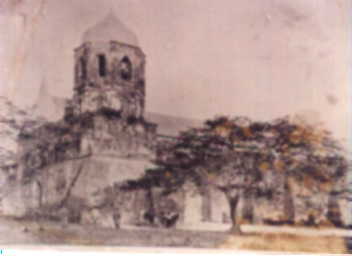
| General Information |
| History |
| Government |
| Barangays |
| Business |
| Places |
| Events |
| Statistics |
| Maps |
| Links |
| E-mail Us |
|
Another project of:
Coun. ALBERTO BUENAVISTA and  Bringing information technology to the community;
Bringing information technology to the community;Linking communities to the world. |

and updated version

An old perspective of St. Andrew's Church in La Huerta.
Beginnings
The then town of Palanyag was founded in 1572. Since the place lay very
proximate to the sea, the Paraqueños did much trade with the Chinese,
Indonesians, Indians and Malayans. At that time the main means of
livelihood were salt-making, fishing, planting rice, shoemaking,
slipper-making and weaving. The community was headed by cabezas de
barangay, a westernization of the local chieftains and the principalia
as the local aristocrats were called, a very durable social
institution since they were the political absorbers. They justified
and moderated the demands of the Spanish colonizers. Education was
limited to the principalia since it is only they who could afford it.
The recorded beginnings of Palanyag began in 1580 when Fr. Diego de
Espinar, an Augustinian missionary, was appointed Prior or superior of
the convent or religious house of the town. As resident priest, he
established the mission house there, with its spiritual jurisdiction
reaching up to Kawit in the province of Cavite. The Council of the
Definitors (or conference of chiefs of the religious orders) held on
May 11, 1580, accepted Palanyag as an independent town.
The image of Palanyag's patroness, Nuestra Señora del Buensuceso, was
brought to St. Andrew's Church in La Huerta in 1625.
Historical accounts state that since Palanyag was located at the
crossroads of Manila, the provinces of Cavite and Batangas, the town's
strategic location enabled the townspeople to play an important role in
Philippine history.
During the invasion of the Chinese pirate Limahong in 1574, Parañaque
residents, particularly those from Barangay Dongalo, heroically aided
in preventing the attack in Manila. This became known as the "Red Sea
Incident" due to the blood that flowed as a result of the defense made
by the people from barrio Sta. Monica, the barangay's former name.
When the British invaded Manila in 1762, the townspeople once again
remained loyal to the Spanish colonizers, especially the Augustinians.
The invasion however showed that the power of the Spaniards was not
invincible and more than a hundred years later, this would prove to
be true.
Then came the Philippine Revolution (circa late 19th century) and the
Spaniards realized that the town was a practical gateway to Cavite,
the bastion of the revolutionary Katipuneros. Conversely to the rebels
based in Cavite, they saw the town as their gateway to Intramuros, the
Spanish seat of government in Manila.
Prominent Paraqueños, like Manuel Quiogue and secular priest Father
Pedro Dandan became leading revolutionary figures.
When the Americans took over, one of the first towns to have a
municipal government was Parañaque.
During the Japanese occupation (circa 1940's), Parañaque supplied the
leadership of the guerilla movement like the ROTC Hunters as well as
food and arms. Parañaque was one of the first towns to be liberated and
its guerillas helped in paving the way for American forces to enter
Manila.
As can be gleaned from the above, Parañaque then and now has and
continues to play a strategic role in the Philippines' political and
economic progress.
Another outstanding feature of this historic town by the bay is the
cultivation of its cultural traditions like the Komedya, Sunduan, and
Bati, among others that continue to attract local and foreign tourists
alike, especially during the summer months.
From Palanyag to Parañaque
Main source : DULCE FESTIN-BAYBAY, Author of the first comprehensive
history of Parañaque, courtesy of Parañaque's City Information Office.
Palanyag, the old name for the city of Parañaque, generally means "my
beloved", among other definitions, for as far as its residents are
concerned, this best describes their affection for their hometown.
Another version came from the combination of the terms "palayan" and
"palalayag", the former meaning ricefields of which the city once
abounded in and the latter pertaining to the sailing and fishing
occupation of many of its residents. This was also a sign of cooperation
and goodwill between the two major working sectors of the town, the
farmers and the fishermen. It was however a drunken guest, during a
certain affair which decided on the final name, who said "Mabuhay ang
Palanyag at ang mga taga-Palanyag! (Long live Palanyag and the people
of Palanyag!)" So the name stuck from that day on.
Another version, according to tradition, was when a Spanish soldier
told the driver of his caruaje or horse-drawn carriage, to "Para aqui,
para aqui (Stop here, stop here)!" The driver, uncomprehending, kept
on prodding his horse to go on while the soldier angrily repeated his
instruction: "Para aqui, para aqui!" Onlookers just laughed as the
Spaniards empathically said "para aniya aqui para aniya aqui (he said
'stop here' he said 'stop here)." For days the incident was repeated
around and term "para aniya aqui" stuck.
There is another story that says of an imposing balete tree at the
mouth of the Parañaque. It looked like a boat sailing slowly and
majestically, earning the Tagalog term Palanyag, a corruption of the
term "palayag" which means "point of navigation". Further adulteration
of the word later resulted in the word "palanyaque".
A historian believes the town's name may have come from the term "palanas"
which means a "broad flat plain," the geographic description of
Parañaque.
Other origins of the name Parañaque are "palanac" (with no special
meaning), "patanyag" or contest for popularity, and "paranac", a native
term for the shell product that used to be the livelihood of the
natives of the town at one time.
Whatever the correct origin of the name of Parañaque, the various terms
strongly suggest the town's storied and mosaic past.
| Back to the top |